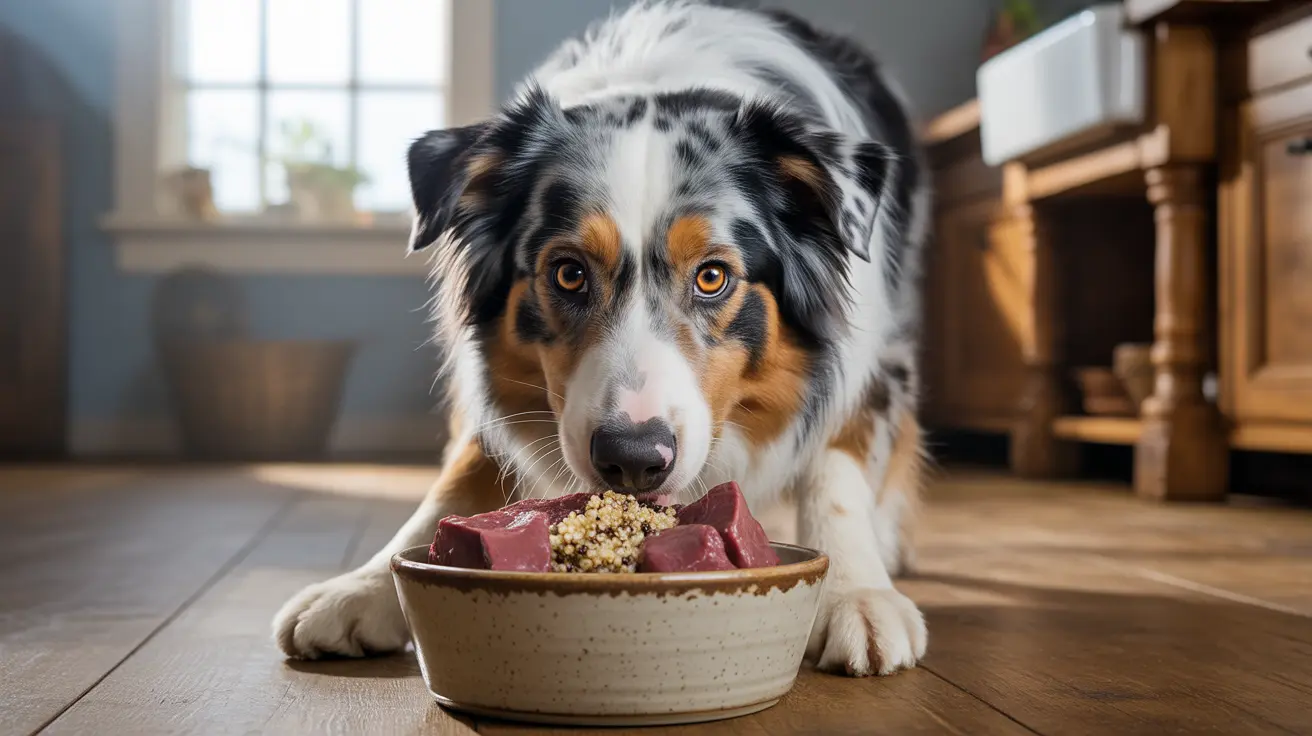Healthy Beef Liver and Quinoa Dog Food Recipe: A Nutrient-Packed Homemade Meal
Creating nutritious homemade meals for your dog doesn't have to be complicated. This beef liver and quinoa dog food recipe combines the exceptional nutritional benefits of organ meat with the complete protein profile of quinoa, delivering a powerhouse meal that supports your canine companion's overall health. As more pet parents seek alternatives to commercial dog food, this veterinary-approved recipe offers a perfect balance of essential nutrients while being gentle on your dog's digestive system.
Beef liver stands out as one of nature's most nutrient-dense foods, packed with vitamin A, B vitamins (particularly B12), iron, copper, zinc, and high-quality protein. When paired with quinoa—a complete grain containing all nine essential amino acids—this recipe provides comprehensive nutrition that supports immune function, muscle development, healthy vision, and sustained energy levels. Whether you're looking to diversify your dog's diet or address specific nutritional needs, this homemade meal offers a wholesome solution that prioritizes your pet's wellbeing.
The Nutritional Powerhouse: Why Beef Liver Excels for Dogs
Beef liver deserves its reputation as a superfood for dogs due to its exceptional nutrient density. This organ meat contains concentrated levels of vitamin A, which plays a crucial role in maintaining healthy vision and skin. The high vitamin A content supports your dog's immune system, helping them fight off infections and maintain optimal health. Additionally, beef liver provides substantial amounts of B vitamins, particularly B12, which are essential for energy production and proper nervous system function.
The iron content in beef liver significantly exceeds that found in muscle meats, making it an excellent choice for dogs that need support with circulation and oxygen transport throughout their bodies. Copper and zinc, also abundant in beef liver, contribute to healthy coat development, wound healing, and proper enzyme function. The protein quality in beef liver is exceptional, providing all essential amino acids necessary for muscle development and maintenance.
Comparing Beef Liver to Other Organ Meats
While beef liver offers outstanding nutritional benefits, understanding how it compares to other organ meats helps you make informed decisions about your dog's diet. Chicken liver contains similar nutrients but typically has lower iron content and slightly different vitamin concentrations. Lamb liver provides comparable nutrition to beef liver but may be easier to digest for some dogs with sensitive stomachs.
Pork liver should generally be avoided for dogs due to potential health risks and higher likelihood of bacterial contamination. Turkey and duck liver offer excellent alternatives with similar nutritional profiles to beef liver. Each type varies slightly in fat content and mineral composition, but beef liver remains one of the most readily available and nutritionally complete options for most dogs.
Quinoa: The Complete Grain for Canine Nutrition
Quinoa stands out among grains as a complete protein source, containing all nine essential amino acids that dogs cannot produce on their own. This ancient grain provides excellent digestibility for most dogs and offers a rich source of fiber that supports healthy digestion and nutrient absorption. The magnesium, iron, and zinc found in quinoa complement the mineral profile of beef liver, creating a synergistic nutritional combination.
Unlike many grains that can cause digestive upset in sensitive dogs, quinoa is generally well-tolerated and provides sustained energy without causing blood sugar spikes. The fiber content helps maintain healthy gut bacteria and supports regular bowel movements. Quinoa's natural gluten-free properties make it suitable for dogs with grain sensitivities, though individual tolerance should always be monitored when introducing new ingredients.
Step-by-Step Beef Liver and Quinoa Recipe
This simple yet nutritious recipe uses human-grade ingredients and can be easily prepared in your home kitchen. The cooking process eliminates potential bacterial contamination while preserving most of the essential nutrients that make this meal so beneficial for your dog.
Ingredients:
- 1 pound fresh, grass-fed beef liver
- 1 cup quinoa, thoroughly rinsed
- 2 cups low-sodium chicken or beef broth (or water)
- Optional: small amounts of dog-safe vegetables like carrots or sweet potatoes
Preparation Instructions:
- Rinse the quinoa thoroughly under cold water until the water runs clear to remove natural saponins
- Cook quinoa in broth or water according to package directions, typically 15-20 minutes until tender
- While quinoa cooks, cut beef liver into small, bite-sized pieces appropriate for your dog's size
- Steam, boil, or lightly pan-cook the liver pieces without any seasonings, oils, or additives until fully cooked (internal temperature of 160°F)
- Allow both ingredients to cool completely before mixing together
- Store in refrigerator for up to 3 days or freeze portions for longer storage
Safe Preparation Guidelines
Never add garlic, onion, excessive salt, or other seasonings that can be toxic to dogs. Avoid using cooking oils or butter, as these can cause digestive upset. Ensure all ingredients are cooked thoroughly to eliminate potential bacterial contamination, especially when preparing organ meats. Always use fresh, high-quality ingredients from reputable sources to minimize exposure to contaminants and maximize nutritional benefits.
Proper Portion Control and Feeding Guidelines
Feeding the correct portion size is crucial for your dog's health and prevents potential issues from overfeeding nutrient-dense ingredients like beef liver. The general guideline suggests that organ meats should comprise approximately 5% of your dog's total daily diet to avoid vitamin A toxicity and other complications.
For small dogs (under 25 pounds), limit beef liver portions to approximately 1 ounce per week, mixed with appropriate amounts of quinoa. Medium dogs (25-60 pounds) can safely consume up to 2 ounces of beef liver weekly, while large dogs (over 60 pounds) may have up to 3 ounces per week. Always adjust total meal portions based on your dog's activity level, age, and overall caloric needs.
Transitioning to Homemade Meals
When introducing this beef liver and quinoa recipe, start with small amounts mixed into your dog's regular food to allow their digestive system to adjust. Begin with just a tablespoon of the mixture and gradually increase over 7-10 days until reaching the desired portion size. Monitor your dog closely for any signs of digestive upset, changes in stool consistency, or allergic reactions during this transition period.
Managing Food Allergies and Sensitivities
While beef liver and quinoa are generally well-tolerated by most dogs, individual sensitivities can occur. Common signs of food allergies or intolerances include itching, skin irritation, digestive upset, vomiting, or changes in bowel movements. If you notice any of these symptoms after introducing the new recipe, discontinue feeding and consult your veterinarian.
Dogs with known beef allergies should avoid this recipe entirely and consider alternatives using chicken liver or other protein sources. Similarly, while quinoa is typically easier to digest than other grains, some dogs may still experience sensitivity to this ingredient. Always introduce new foods gradually and maintain detailed records of your dog's response to identify potential problem ingredients.
Raw Versus Cooked: Making the Right Choice
While raw beef liver retains slightly higher levels of certain nutrients, cooking provides important safety benefits by eliminating potential bacterial contamination and reducing the risk of foodborne illness. Dogs with strong immune systems may tolerate raw liver better, but this approach requires extremely careful sourcing from reputable suppliers and should only be undertaken with veterinary guidance.
Cooking methods like steaming, boiling, or light pan-cooking preserve most of the nutritional benefits while ensuring food safety. The slight reduction in certain vitamins from cooking is generally outweighed by the safety benefits, especially for dogs with compromised immune systems, elderly dogs, or puppies with developing digestive systems.
Adding Complementary Ingredients for Balanced Nutrition
While beef liver and quinoa provide excellent foundational nutrition, adding small amounts of dog-safe vegetables can enhance the meal's vitamin and mineral profile. Carrots provide additional vitamin A and fiber, while sweet potatoes offer complex carbohydrates and potassium. Steam these vegetables until soft and cut into appropriate sizes for your dog.
Avoid adding any ingredients that are toxic to dogs, including onions, garlic, grapes, raisins, or chocolate. Stick to simple, whole food ingredients and consult with your veterinarian about appropriate supplements if you're planning to make homemade meals a significant portion of your dog's diet.
Troubleshooting Common Digestive Issues
Some dogs may experience temporary digestive adjustments when transitioning to new foods, including changes in stool consistency or mild stomach upset. These issues often resolve within a few days as the digestive system adapts. Ensure you're introducing the new recipe gradually and not exceeding recommended portion sizes for organ meats.
If digestive issues persist beyond a few days or worsen over time, reduce the portion size or discontinue the recipe temporarily. Persistent problems may indicate individual food sensitivities or underlying health issues that require veterinary attention. Always prioritize your dog's comfort and health when introducing new foods.
Frequently Asked Questions
How often can I feed my dog this beef liver and quinoa recipe?
This recipe can be fed 2-3 times per week as part of a balanced diet, ensuring that organ meats don't exceed 5% of your dog's total daily food intake to prevent vitamin A toxicity.
Can puppies eat beef liver and quinoa?
Puppies can eat small amounts of this recipe, but they require different nutritional ratios than adult dogs. Consult with your veterinarian before introducing organ meats to puppies, and always start with very small portions.
What should I do if my dog has an allergic reaction to this recipe?
Stop feeding the recipe immediately and contact your veterinarian. Document any symptoms you observe, such as itching, digestive upset, or skin irritation, to help identify the specific allergen.
Can I substitute chicken liver for beef liver in this recipe?
Yes, chicken liver can be substituted using the same preparation methods and portion guidelines. Chicken liver has similar nutritional benefits but may be easier to digest for some dogs.
How long can I store prepared beef liver and quinoa meals?
Store prepared meals in the refrigerator for up to 3 days or freeze individual portions for up to 3 months. Always thaw frozen portions completely before serving and never refreeze thawed meals.
Is it safe to feed this recipe to senior dogs?
Senior dogs can benefit from this nutrient-dense recipe, but they may need smaller portions and more gradual transitions. Consult your veterinarian about appropriate serving sizes for older dogs with potential health conditions.
What signs indicate my dog is getting too much vitamin A from beef liver?
Signs of vitamin A toxicity include bone deformities, weight loss, digestive issues, and lethargy. If you notice these symptoms, reduce or eliminate liver intake and consult your veterinarian immediately.
Conclusion
This beef liver and quinoa dog food recipe offers a nutritious, digestible meal option that supports your dog's overall health through high-quality protein, essential vitamins, and complete amino acids. By following proper preparation methods, portion control guidelines, and safety precautions, you can provide your canine companion with a homemade meal that rivals commercial dog food in nutritional value while offering the satisfaction of knowing exactly what goes into your pet's bowl.
Remember that individual dogs have unique nutritional needs and sensitivities, so always introduce new foods gradually and monitor your pet's response. While this recipe provides excellent foundational nutrition, maintaining variety in your dog's diet and consulting with your veterinarian ensures the best possible health outcomes for your beloved companion. With careful preparation and attention to your dog's individual needs, this beef liver and quinoa recipe can become a valuable addition to their regular meal rotation.





